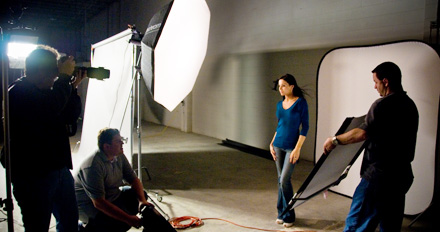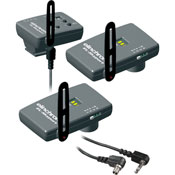Yesterday we talked about my continuous lighting set-up, but today we’re moving onto pro-quality studio flash. Here’s the thing: I could spend the day talking about really low cost strobes, but when it comes to strobes, this is one area where buying the “good stuff” really pays off (I learned this the hard way).
Back in January of this year, I gave up on all my old studio gear (made up of a hodge-podge of Photogenic, White Lighting, and Profoto monobloc strobes, with a host of different sized Chimera softboxes), and I bought a whole new set-up from the ground up and it’s the best thing I ever did. So, before we go on I want to mention two important things:
- I’ve been reading your questions posted in the comments sections each day, and I’m hoping (focus on the word “hoping”) to be able to post an FAQ either tomorrow, or on Monday where I’ll try and answer as many of your questions as I can about the stuff I’ve talked about here on Lighting Gear Week.
- The set-up I’m about to tell you about is the exact same set-up I now use exclusively when I’m shooting in-studio strobes (tomorrow’s post is what I do for studio shoots on location), but this stuff ain’t cheap. Great equipment rarely is (although I think you’ll be surprised that it’s not as much as you might think). I recommended this same set-up to one of my very best friends a few weeks ago, he bought it, and you’ll read more about his experience later on. So, just so you know now; this is serious pro-quality gear, at pro quality prices, so go forward with that in mind.
Now, why aren’t I showing you a cheap studio strobe set-up? Because you wouldn’t thank me later. I’m giving you the same advice I would, and do, give my closest friends, and this is absolutely what I would tell them to get:
- Two (2) Elinchrom RX600 600-watt Monolight Strobes (the Monolight thing means they plug right into a wall socket like any other thing that runs on electricity). They are $978 each at B&H Photo (link) NOTE: There is a special reason why I chose these, and I’ll share that in a moment.
- An Elinchrom 53″ Midi-Octa softbox (this will be your main light. It’s huge. It makes stunningly beautiful light. You will love it) It’s $308 at B&H (link) and includes the speed ring (the thingy that lets you attach the softbox to the your light). That’s the MidiOcta in use in the photo up top (photo by RC Concepcion)
- An Elinchrom Rotalux 14″x35″ softbox (this is tall and thin like a striplight; and it makes a great hair light, kicker light, fill light, or even a good background light). It’s $198 at B&H (link) and includes the speed ring. By the way; one thing I dearly love about these softboxes is that they collapse like an umbrella for the storage with the speed ring still attached. A huge time (and pain in the butt) saver.
- An Elinchrom Skyport RX Radio Slave System, which includes one transmitter and two RX receivers. This is what wirelessly triggers the strobes, and are a key piece of this set-up. They are why I stopped using other wireless flash triggers. In fact, these Skyports are so great, that I’m giving them, right here and now, my “Scott Thinks It’s Hot” Award (you’ll see why in a minute). The set, which powers both strobes wirelessly, is $260 (link).
- Two Avenger A420 rolling 9’10” light stands with Boom Arms added. This things are solid as a rock, handy as all get-out, they roll (rolling is big), and your back will thank you again and again. Don’t put great lights on crappy stands. It’s like putting WalMart tires on your Turbo Porsche. You have to buy the stand, then the boom arm separately. The stands ain’t cheap–they’re $180 for each stand (link to B&H), plus whatever the boom costs (you’ll have to ask B&H which boom arm you should get—I couldn’t figure out which ones we have, because I’m at home tonight). Technically, you could get away with one boom, and leave your main light on just the straight stand, but you’ll always secretly wish you had that 2nd boom, which comes in very handy.
- A Reflector and boom arm holder (you can use the Westcott 30″ reflector I mentioned yesterday and the day before). You don’t need a fancy stand for this. However, since you’re “movin’ on up” you might consider a larger reflector (especially if you’re doing full length shots), like the Westcott Illuminator Collapsible 48″x72″ Silver/White reflector, for $105 (link).
So, before we go any further, let’s total up our gear:
For everything, except the Avenger lightstands and larger reflector and stand, the total for the two strobes, two softboxes, and Skyport triggers is $2,721 (that’s not that bad, for a kick-butt pro system).
Now that you know what it all is; why? Why did I buy this stuff (and what makes it so great)? I think Elinchrom makes an absolute top quality product, (just ask Joe McNally, who uses Elinchrom, and is actually the guy who turned me onto them in the first place), but they’re still at a realistic price. In fact, I’d say in price-to-quality ratio, they’re actually a real value. But that’s only part of the picture for me. What sold me was how this all works with the Skyports, and the free Skyport software.
Skyports
When I first saw the Skyports, I was immediately drawn to their incredibly small size (about the size and weight of a box of matches). The Transmitter that sits on your hot shoe is only 1 inch high. 1″ inch! No more trying to see around the big transmitter sitting on top of my camera just to see my subject (you don’t realize how big those other transmitters are until you try a Skyport). The Skyports are so darn small, and so light, that everyone who sees them has to smile. But that’s not why I fell in love.
What made me fall in love with Skyport is:
- The fact that with Elinchrom RX strobes, I can control the power of each strobe right from the transmitter on top of my camera. If I want the hair light down a half-a-stop, I can do it without leaving my camera position. If I want the background light brighter, it’s just two clicks.
- I can turn on/off the modeling lights the same way; from right on that tiny transmitter
- When you buy Skyports, you can also buy a USB key for your computer (it’s around $100), and then you can download this amazing software that lets you run your entire studio, all of your strobes, right from your computer (for Mac and PCs). It actually shows you a visual representation of the exact back of the RX strobes, right there on screen, but it’s live—you can move the sliders, turn on/off things, and do anything you could do on the strobe itself, from right on your computer screen. But this is just the tip of the iceberg of what this software will do (including memorizing and saving your set-ups, so when you come back to the studio a week later, it will automatically feed all the right settings into all your strobes). This “running your studio wirelessly” and by software, is the future of the efficient studio, and it will rock your world. (did I mention this amazing software is free! It’s FREE!)
- The Skyports cost less than the PocketWizard Plus IIs I’ve been using, because they’re $189 each, and you would need three of them (one on your camera, and one on each of the strobes). That’s $567, vs. just $260 for the Skyport kit (one on your camera, and one on each of the strobes). Go to Elinchrom.com to learn more about the Skyports. You will dig them, big time.
Once I tried this whole thing out (skyports and RX strobes), at their booth at Imaging USA, I ordered this same kit right on the spot. Since then, I ordered one more RX-600 to use as a background light because I was getting tired of running back there and changing the power output all the time. (Note: While the Universal Skyport kits will trigger any flash units, to get the whole “Raise and lower the power/turn on/off the modeling lights thing, and use the cool software” you have to have Elinchrom RX strobes, and order the RX transmitter kit instead of the Universal kit).
True story: A few weeks ago I flew up to Detroit to spend a day with my buddy Terry White. We wound up in the studio, and Terry was really unhappy and frustrated with his el cheapo strobe system, and of course I teased him about it unmercifully. Terry called a day or two later and said he was sick of dealing with all his strobe issues, and would I recommend a really great pro set-up for him. I sent him a B&H wish list with the same exact things you see there (the same exact stuff I use myself), and Terry went right online and bought the whole system. He shot with it that weekend, and he had to call me in the middle of his shoot to thank me. His exact words here, “Dude, I had no idea that it would make as big a difference as it did.” He was absolutely thrilled, and has thanked me numerous times since then.
Now, I did the same thing for you. I put together a B&H Photo Wish List, with all that gear, with pricing, and direct links for more info, just to put it all in one place. Here’s the link to my Elinchrom Wish List. (I know many of you are probably tired of hearing me repeat this, but just so you know I don’t get a kick-back or commission or referral fee, etc. on anything you buy from Elinchrom or B&H).
That’s it for today folks–tune in tomorrow for my wrap-up, with location lighting using serious strobes. Don’t forget to bring your checkbook—location lighting makes this stuff look like a bargain. See you then!





